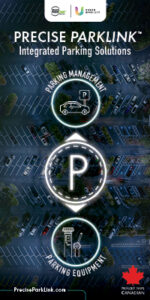Dissecting Parking in a Smart City
By Chelsea Webster
Parking is an easy first step for a municipality to take towards becoming a smart city because the technology already exists, and it can be tested and proven with minimal resources.
Key points
- A Smart City is defined by sensors that collect information and relay it to a hub, which recommends actions based on data analysis. Smart parking is applying this concept to parking.
- Citizen and government engagement and interaction is critical to the success and long term viability of the smart city concepts.
- Smart parking is a subset of the smart city concept that’s easily implemented; pros and cons exist, however the net impact is positive.
- Many other technologies (like autonomous vehicles) are impacting the adoption of smart parking and often creating more questions than answers.
Action: Three actionable suggestions can be found at the end of the article if you are interested in implementing smart parking in your municipality.
What is a Smart City?
The term “Smart City” has been making the rounds lately, and I’d venture a guess you’ve heard it once or twice by now (or perhaps you live and work outside the realm of this concept, which is fine too). But for everyone who has heard it, as much as for those who haven’t, what does it actually mean? For all the hype, it still isn’t listed on Dictionary.com or Merriam-Webster. A smart city is a broad concept, with no precedent, and as of yet, there aren’t set standards as to what defines a city as smart. Oh. Now what?
There are a lot of working pieces involved in the smart city concept, but let’s break it down into two key components: technology (physical and virtual requirements) and data (collection and application).
1. Technology
This is the network of sensors, cameras, and other devices that get built into the physical streets and features of a city. They become part of the infrastructure and go virtually unnoticed. Left alone, they monitor everything around them from the temperature to counting pedestrians and cars to noise levels. They note traffic patterns and disruptions, they capture energy usage, and they even track how full the garbage can on the corner is. As the data is collected, sensors transmit (via Wi-Fi, radio, Ethernet, etc.) information to the cloud for storage, compiling, analysis, and action. A secure, reliable network is essential for any smart city.
2. Application
Once the data is collected, the possibilities are unlimited. Public transit is a great application – information on minutes until the next bus, route details, travel time, and accidents can be collected and relayed in real time on electronic displays or through an app on a passenger’s cell phone. Other common industries include traffic management, energy and utilities, environmental monitoring, healthcare, water use, waste management, safety, preventative and reactive maintenance, emergency services1… the list goes on.
Got it. The one thing we haven’t covered yet is how the data, once analyzed, is shared. With people, data is communicated through smartphones and tablets via apps. With other computers, data is transmitted electronically through the available network (often going back out to the same sensors it came from).
But what’s the point of doing all this? Well, it’s hugely beneficial to citizens. Video monitoring can stop or solve crimes, traffic updates help you avoid major delays on your commute, and if there’s an accident an ambulance is on the way immediately. It’s also immensely beneficial to the city. Street lights can be dimmed when not in use to save on energy costs, water main breaks can be avoided with early detection, and waste collection can be scheduled only as needed2. And some of the applications are good for everyone, like sound sensors to handle noise pollution and detect gunfire or temperature sensors to schedule snow removal or otherwise deal with road conditions3.
The key to all of these opportunities is that the analysis of all the data collected creates (often automated) action. Summarize the information, generate a plan, do something!
How does parking fit in?
As we just discussed, the concept of a smart city is extremely broad, and the technology can be applied in thousands of ways. If you’re a municipality, trying to get people (both citizens and government) on board with incorporating sensors into every aspect of city life is a big task. What if you had a small scale project, integrated it with existing technologies, implemented the project quickly, minimize costs and initial investment, and saw a return on investment in 12 months4? Seems like a good way to test the smart city infrastructure and have a successful outcome.
That’s what smart parking can offer. There are dozens of great parking apps on the market, which can be branded and launched almost immediately upon purchase. The functionality of the new app includes mobile payment, online booking, and helping motorists find a parking spot. Fast forward one year and you’re seeing both sides of the
equation benefit:
Citizens: 94%+ satisfaction rating with the new system (as a benchmark, that’s what ParkPlus consistently receives in our independent customer surveys5), less frustration when parking, and more space availability.
Municipality: demand based parking increases revenue, enforcement is significantly more efficient, administrative time in citation management is reduced, and data is abundant for strategic planning.
Admittedly, one of the big challenges of smart city technology is that you need citizens to be engaged – in our parking example, they would have to download your app. It’s both simple and quite difficult at the same time. However the sensors, apps, and all the related parking technology not only exist, but are readily available; so it remains a relatively easy win for smart city enthusiasts.
Larger Scale Examples
When looking specifically at parking, there are two well illustrated examples that are worth further exploration.
Calgary: The Calgary Parking Authority saw an opportunity to improve the parking experience for its citizens and developed (in-house, mind you) a first-of-its-kind solution. This comprehensive system migrated the city to a multi space meter based on pay-by-plate, an app to easily manage your parking sessions, improved processing of violations, and dozens of other benefits.
San Francisco: SF park is a federally funded study using real time data and demand responsive pricing to bring motorists a better way to find and pay for parking. It doesn’t specifically say so on their website, but I’d venture a guess Donald Shoup had a hand in this. An abundance of information including a report on their successes and other findings can be found at this site: http://sfpark.org/about-the-project/pilot-evaluation/
However, a smart city really is an all-encompassing, far reaching term. One more example to illustrate how big a deal this concept is: the US Department of Transportation held a contest for municipalities to submit their best smart city plan to win funding and support. 78 municipalities entered, each with their own detailed plan on how they want to transform their own city (from improving healthcare to eliminating homelessness). I won’t spoil the results, but if you can learn about the project at this site: https://www.transportation.gov/smartcity
The Nitty Gritty of Smart Parking
It’s about that time to get into the details of how parking technology, applied in the smart city framework, can actually make a difference.
The Good: There are several parties who benefit from smart parking, including motorists, municipalities, tourists, businesses, and the environment. Developers are creating new possibilities for app functionality6, however this is just the beginning. Specific to parking, we can look forward to:
- Lower capital, collection and maintenance costs (with fewer meters, since they are virtually unnecessary)
- Demand based pricing can be implemented7 and in turn increase availability of open spaces
- Long term, strategic planning can be done based on current facts and figures (using data collected and assembled from the sensors)
- Real-time push notifications for motorists to extend parking sessions and avoid tickets
- Notification to foot patrol officers with locations of offending vehicles; this enables route planning and maximum revenue per hour
- Motorists can find parking quicker and easier, or even plan ahead of their arrival
- Traffic congestion from cruising for parking decreases
- Environment benefits from less pollution8
- One set of sensors could have multiple data points collected, and therefore as number of uses go up, cost per benefit is reduced
The Bad: As with any new technology, there are drawbacks. Most of these can be successfully tested with best practices emerging over time, and are generally not big enough deterrents to warrant not investing in smart parking. They include:
- Technology is outpacing policy, leaving the environment unregulated and without development standards
- City officials are often not involved in discussions, planning or other activities (and how do you convince them they should be?)9
- Budgets constraints and lack of planning make it a financial burden to research, purchase and install the best technology10
- The investment required may not have yet proved to produce profitable returns, so the incentive to invest in this infrastructure is low
- Using the smart parking app on your phone while looking for parking is a safety hazard at best, and at worst a ticketable offense
- Smaller, rural areas might not have the required network connections or smartphone access for the majority of the population, making it impossible to collect information or communicate with users in a timely manner
The (Near) Future
As with every new technology, there are positives and negatives to full adoption. Below are a few of the most prominent factors on the horizon that are likely to impact our adoption of smart parking technology.
Autonomous vehicles: it’s going to be critical to become a smart city in the age of autonomous vehicles; cars will need to know where there is space for them while they wait for their next passenger. There are two trains of thought on this – some say we’ll need less parking because cars will always be driving11, and some say we’ll need even more, but further away, as no one will be willing to pay for premium parking when it’s equally as convenient for you to have your car park itself long distances from your destination.
Infrastructure: do we need different types of parking structures to accommodate parking demands? How do we modify what we already have to incorporate the required sensors? Do entire streets need to be retrofitted to install sensors? Or maybe more advanced technology is required before implementation? A set of standards or building codes would be a great reference point for cities looking to get started.
Parking minimums: with more information about the exact location of available parking, in addition to so many other technologies reducing vehicle ownership needs, the total number of spaces required will likely decrease. It seems logical that cities will in turn reduce or eliminate requirements for builders to include high numbers of stalls per square foot of development. One example is Buffalo, who recently became the first city in the US to remove all parking requirements city wide12.
Millennials: with the new generation of adults moving into urban centres, their lifestyle is drastically different than previous generations. They are extremely tech savvy (read: they will demand smart cities with smart parking), and open to other forms of transportation (like Uber and Lyft)13. This will increase the demand and urgency for cities to
become smart in regards to transportation if they want to retain the population base.
Land management: there are approximately 1 billion parking spots in the US right now, however only 253 million cars14. Does each and every car really need 4 parking spots? Using the existing spaces more efficiently would save space and allow for more dense neighbourhoods. Repurposing or converting parking into new things is becoming more commonplace, as well as multi-use buildings where new developments are being built. Side note – wastelands are fascinating and if you want to see what abandoned parking, schools, malls, fishing towns, or pretty much anything else looks like, I highly recommend watching an episode of the Viceland show Abandoned. https://www.viceland.com/en_us/show/abandoned
Sharing economy: with companies like AirBnB, Rent the Runway, Car2Go and Lyft, it is hard not to notice that people are making a shift towards a sharing economy. It enables society to consume fewer things, create less waste, and ultimately you can get what you need for less money. It’s no surprise that sharing parking spaces is an application of the shared economy, considering how many spots actually exist and how temporary your stay in one likely is; we already need and use apps and connectivity for this process. Taking it a step further – perhaps we’ll even be sharing car ownership – and if we do, we’ll need the technology a smart city provides to figure out where the car is and when it’s available.
What else is smart parking capable of helping us with?
Now I’m not suggesting the list I’m about to share is a bunch of new ideas. These parking technologies exist right now; maybe you even used an app that does these things already today. If so, be sure to share your successes and failures! Here are a few possibilities:
- Traffic analysis to determine if you should drive to your destination and park, or if taking an alternate means of transportation is more time and cost efficient
- Email or text alerts based on your parking session, so that if you stop or exit your vehicle in a no parking zone, or your virtual meter runs out, you receive and alert before you get a ticket
- Bike parking and tracking, plus types of facilities for cyclists at your destination (locks? Showers?)
- Post session monthly billing for your parking, similar to how your cell phone provider bills you (or for all of our southern Ontario readers, just like the Hwy 407 transponder works)
- Video monitoring parking areas for safety, crime prevention, lighting conditions, space availability, foot traffic patterns, ease of parking, use of accessibility spots, etc. plus access to this information
Great information, but what the heck am I supposed to do with it?
Well, if you’re looking to get smart parking going in your city, I’d start with an online search for smart parking management. Next, you can give a CPA member such as the Calgary Parking Authority a call and ask about their experience as a municipality.
If you’re well beyond that and want to develop your own app to implement smart parking, check out ThingWorx – it’s a platform that lets you build an app or dashboard to convert sensor data into actionable information15. Or watch this YouTube video16 and learn how to install and sync sensors from scratch.
And after all of this if you just plain old think parking should go the way of the dodo, how about organizing a one day vehicle closure of a major road in your city? Find the blue print for that here (yes, it’s a thing, and it’s called the Open Streets Project17) – and unwelcome parking in your neighbourhood. Heck, if it’s in Calgary I’ll join you for a rollerblade (as long as it’s not up hill).
For more information on ParkPlus System
www.getparkplus.com @getparkplus.
1 http://www.smartcitiesprojects.com/whats-the-real-mean-of-smart-city/
2 http://www.computerworld.com/article/2986403/internet-of-things/just-what-is-a-smart-city.html?page=2
3 http://www.newcitiesfoundation.org/smart-parking-makes-way-smart-cities/
4 https://www.thingworx.com/blog/smart-parking-smart-cities/
5 https://annualreport.calgaryparking.com/pdfs/2016-0951-CPA%20Customer-Satisfaction-Survey.pdf
6 https://www.link-labs.com/smart-parking-prepare-for-launch-of-citywide-application/
7 http://www.smartcitiesinsider.com/smart-parking-solves-challenges-in-cities/
8 https://www.thingworx.com/blog/smart-parking-smart-cities/
9 https://theurbantechnologist.com/2016/02/01/why-smart-cities-still-arent-working-for-us-after-20-years-and-how-we-can-fix-them/
10 http://www.smartresilient.com/5-reasons-why-smart-cities-fail
11 http://www.motherjones.com/environment/2016/01/future-parking-self-driving-cars
12 https://buffalonews.com/2016/12/27/city-code-21st-century/
13 http://www.goldmansachs.com/our-thinking/pages/millennials/
14 http://www.motherjones.com/environment/2016/01/future-parking-self-driving-cars
15 https://youtu.be/Bn9-JtcSSB4
16 https://youtu.be/qfTuwV3KWV4
17 http://openstreetsproject.org/






If this has worked in cities like Calgary and San Francisco, then I can wait to see how in will work in bigger cities like Toronto. They are starting to use this technology in big shopping malls like Yorkdale and Square one. I think it will be a positive when we use this in the GTA. Hopefully people will not be on their cell phones looking for information of a smart city.